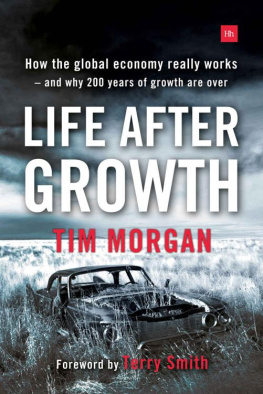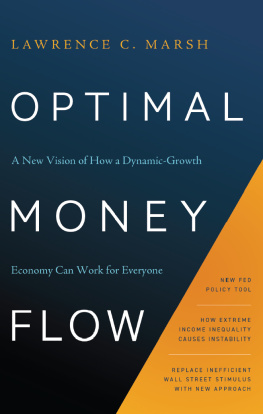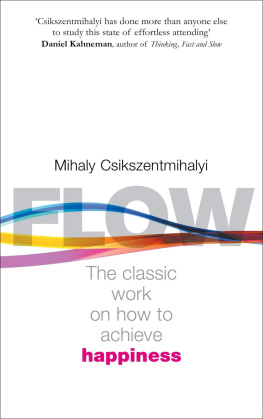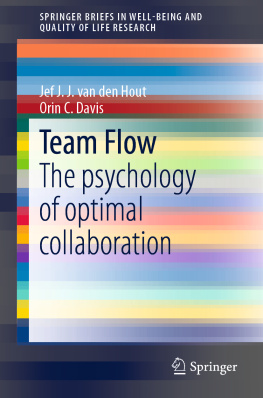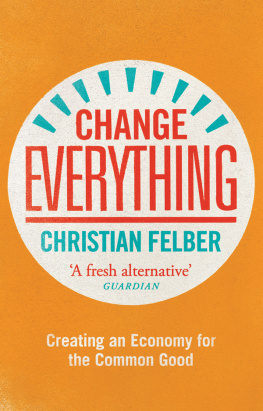Lawrence Capron Marsh - Optimal Money Flow : a New Vision of How a Dynamic-Growth Economy Can Work for Everyone
Here you can read online Lawrence Capron Marsh - Optimal Money Flow : a New Vision of How a Dynamic-Growth Economy Can Work for Everyone full text of the book (entire story) in english for free. Download pdf and epub, get meaning, cover and reviews about this ebook. year: 2020, genre: Politics. Description of the work, (preface) as well as reviews are available. Best literature library LitArk.com created for fans of good reading and offers a wide selection of genres:
Romance novel
Science fiction
Adventure
Detective
Science
History
Home and family
Prose
Art
Politics
Computer
Non-fiction
Religion
Business
Children
Humor
Choose a favorite category and find really read worthwhile books. Enjoy immersion in the world of imagination, feel the emotions of the characters or learn something new for yourself, make an fascinating discovery.

- Book:Optimal Money Flow : a New Vision of How a Dynamic-Growth Economy Can Work for Everyone
- Author:
- Genre:
- Year:2020
- Rating:5 / 5
- Favourites:Add to favourites
- Your mark:
- 100
- 1
- 2
- 3
- 4
- 5
Optimal Money Flow : a New Vision of How a Dynamic-Growth Economy Can Work for Everyone: summary, description and annotation
We offer to read an annotation, description, summary or preface (depends on what the author of the book "Optimal Money Flow : a New Vision of How a Dynamic-Growth Economy Can Work for Everyone" wrote himself). If you haven't found the necessary information about the book — write in the comments, we will try to find it.
Optimal Money Flow : a New Vision of How a Dynamic-Growth Economy Can Work for Everyone — read online for free the complete book (whole text) full work
Below is the text of the book, divided by pages. System saving the place of the last page read, allows you to conveniently read the book "Optimal Money Flow : a New Vision of How a Dynamic-Growth Economy Can Work for Everyone" online for free, without having to search again every time where you left off. Put a bookmark, and you can go to the page where you finished reading at any time.
Font size:
Interval:
Bookmark:


This publication is designed to provide accurate and authoritative information in regard to the subject matter covered. It is sold with the understanding that the publisher and author are not engaged in rendering legal, accounting, or other professional services. Nothing herein shall create an attorney-client relationship, and nothing herein shall constitute legal advice or a solicitation to offer legal advice. If legal advice or other expert assistance is required, the services of a competent professional should be sought.
Published by Avila University Press
11901 Wornall Road
Kansas City, MO 64145
Copyright 2020 Lawrence C. Marsh
All rights reserved.
Thank you for purchasing an authorized edition of this book and for complying with copyright law. No part of this book may be reproduced, stored in a retrieval system, or transmitted by any means, electronic, mechanical, photocopying, recording, or otherwise, without written permission from the copyright holder.
Distributed by Greenleaf Book Group
For ordering information or special discounts for bulk purchases, please contact Greenleaf Book Group at PO Box 91869, Austin, TX 78709, 512.891.6100.
Design and composition by Greenleaf Book Group
Cover design by Greenleaf Book Group
Publishers Cataloging-in-Publication data is available.
Print ISBN: 978-1-7342252-0-4
eBook ISBN: 978-1-7342252-1-1
Audiobook ISBN: 978-1-7342252-2-8
Part of the Tree Neutral program, which offsets the number of trees consumed in the production and printing of this book by taking proactive steps, such as planting trees in direct proportion to the number of trees used: www.treeneutral.com |  |
Printed in the United States of America on acid-free paper
20 21 22 23 24 2510 9 8 7 6 5 4 3 2 1
First Edition
I would especially like to thank Janet K. Marsh, Erik Tyler, Elizabeth Brown, and Jeffrey Curry for their perspective, insights, and guidance in the writing, editing, and publishing of this book.
M y wife and I had just gotten back from the bank. As we pulled into the garage, I saw some papers blowing around the front yard and told my wife I would go and get them. We left the garage door open as she swept the walk and I chased the papers.
We had seen the stranger in the alley behind our home earlier that day. But we didnt see him sneak into the garage, grab my wifes purse, and steal her cash.
The next day I saw him again. This time I followed him down the alley. When I caught up with him, I explained that anyone stealing small amounts of money here and there was making a mistake. I told him what he really needed was not money but money flow. These neighborhood families were making six-figure salaries, but he was just getting occasional crumbs. Fighting over the crumbs is no way to get rich, neither for an individual, nor for a country. I never saw him again. Perhaps he was afraid of getting caught or wanted to avoid another boring lecture.
Money flow is important in the international economy, in the domestic economy, and in state, city, and local economies, just as it is in our own familys economy. Too often we think of money as a static concept. We fight over the economic pie. But, in reality, money is a dynamic flow. Money flows through our economy just as blood flows through our body. Our economic well-being and that of our fellow citizens is more closely defined by our money flow than by the amount of money we have at any particular time. Just as getting money flow right is important for us as individuals, it is also important for us at the local, state, national, and international levels.
Market efficiency requires that marginal benefits match marginal costs. College courses in introductory economics focus on the purest form of market equilibrium, where there are no externalities; no common property resources; no public goods; no fallacies of composition; no deviations from transparent, full-information, competitive markets; and where, at least on average, consumers behave as rational, independent decision makers. Traditional economic theory treats government as exogenous to the system with, at least in theory, no essential role to play other than to maintain the peace and enforce contracts.
Of all these sins of commission or omission, one of the worst is the fallacy of composition that confuses microeconomics with macroeconomics. Too often people make the mistake of assuming that individual-level microeconomic incentives can simply be aggregated to determine economy-wide macroeconomic effects. A simple example is what economists call the paradox of thrift, where everyone trying to save more during a recession (an example of microeconomic activity) leads to a reduction in total savings as the economy shrinks (a macroeconomic effect). In other words, more people trying to save more during a recession leads to a fall, rather than a rise, in total savings. Understanding microeconomic incentives does not automatically inform us about which macroeconomic policies will lead to efficient resource allocation.
Money flow dynamics are subject to the laws of mathematics. This is especially important for achieving economic stability and equilibrium. When you square a number between zero and one, it gets smaller. But and other such analyses that the parameters that control our economy do not always stay between zero and one and, therefore, do not always move us toward convergent stability and equilibrium. Instead, our economy can be driven by contagion effects and other automatic processes toward divergent instability in the face of either irrational exuberance or a downward recessionary spiral.
George Cooper has proposed a wealth flowor money flowparadigm with government at the center of capitalism and the free enterprise system. Cooper points out that before 1628, the medical profession mistakenly followed a blood flow paradigm (framework for thinking) that assumed that our blood originated in the liver and flowed outward where it evaporated at our extremities (fingers and toes). Previous economic paradigms have followed a similar path in assuming that government is, or at least should be, just an outside observer with no essential role to play in economic activity, when in reality, government is the heart of the free enterprise system, with money flowing in a circular loop.
The new money flow paradigm replaces the classical, neoclassical, Austrian, monetarist, and Keynesian schools of economic thought, which are all based on the old exogenous government paradigm and assume that government generally detracts from the efficient allocation of resources. In contrast, the money flow paradigm sees government as playing a key role in bringing about economic efficiency. There are many circumstances where government corrects free market allocations and brings marginal benefits in line with marginal costs.
In an earlier book, Cooper rejected the efficient market hypothesis that is explicitly or implicitly endorsed by most of the previous paradigms. Under his financial instability hypothesis, Cooper notes that while markets for goods and services generally operate efficiently, with negative feedback loops slowing demand as prices rise and increasing demand as prices fall, financial markets tend to do the opposite using positive feedback loops: rising prices increase demand, and falling prices drive investors to sell their shares and leave the market.
Next pageFont size:
Interval:
Bookmark:
Similar books «Optimal Money Flow : a New Vision of How a Dynamic-Growth Economy Can Work for Everyone»
Look at similar books to Optimal Money Flow : a New Vision of How a Dynamic-Growth Economy Can Work for Everyone. We have selected literature similar in name and meaning in the hope of providing readers with more options to find new, interesting, not yet read works.
Discussion, reviews of the book Optimal Money Flow : a New Vision of How a Dynamic-Growth Economy Can Work for Everyone and just readers' own opinions. Leave your comments, write what you think about the work, its meaning or the main characters. Specify what exactly you liked and what you didn't like, and why you think so.

